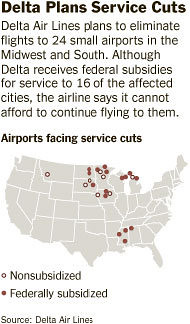Two more examples of the need for a National "Master Transportation Plan"
Most readers of the blog (except for those from Arlington County probably) are tired of how I go on about how great the Arlington County Master Transportation Plan is.
Delta’s announcement was especially acute because the airline operates in most of the small airports that receive a total of almost $200 million in federal subsidies to maintain air service under the Essential Air Service program. The subsidies are scheduled to expire in 2013 unless revived by Congress. Delta acquired many of those small-city markets in the Midwest when it merged with Northwest Airlines.

Airlines say that simple economics are driving them out of small-town America. With fuel prices high, carriers have been reducing domestic routes and seating capacity to focus on the flights that bring in the most revenue per plane — typically those in larger cities, especially major hubs. At the same time, airlines are removing less fuel-efficient aircraft from their fleets, including the 50-seat regional jets that have been the backbone of air service in small- and midsize markets.
“We just don’t have airplanes that can serve small communities economically anymore,” said Michael Boyd, the president of the air-service consulting firm Boyd Group International. “And unless somebody wants to pay a whole lot of money to carry a few people out of the airport at Thief River Falls, it just ain’t going to happen anymore for a lot of those places.”
In all likelihood, these places would be better served by train service, maybe not high speed rail, but higher speed than is currently available... But because we don't have a national transportation plan, making these kinds of focused choices between modes, based on cost and benefit, isn't really done.
2. Today the US PIRG has released a report, High-Speed Rail: Public Private or Both? Assessing the Prospects, Promise and Pitfalls of Public-Private Partnerships, which looks at how how high-speed railroad service should be funded in an objective, rather than ideological, fashion. According to the press release:
“The report shows that private financing can be a supplement but not a substitute for public support of high-speed rail,” said Phineas Baxandall at U.S. PIRG. “In other nations the majority of support comes from the public sector. The rail companies overseas often have public ownership and the public on their board like a public utility or Amtrak.”
The report cautions that public-private partnerships in other countries have a mixed record. When private financing has been a short cut around public investment, taxpayers often end up paying dearly. Partnerships must have the highest levels of transparency, clear rules of accountability, and strong public capacity for monitoring and enforcing agreements, says the report.
President Obama has put forth the goal of linking 80 percent of the U.S. population via high-speed rail by 2035. Compared to the United States, other industrialized nations around the globe tend to be far ahead of the United States in developing high-speed rail and invest a far greater portion of Gross Domestic Product on infrastructure.
“While many in Congress are having trouble finding money to invest in high-speed rail, they need to consider the costs of not moving forward,” said Baxandall. “Without high-speed rail, we will be more dependent on oil and will pay dearly to build more airport runways and ever-wider highways.”
World-wide, most transportation infrastructure is funded in some way, in whole or in part, by local, state, and national governments. In the US the focus on privatization can be an ideology rather than a careful consideration. I fear that this is the case with proposals for railroad passenger service expansion.
Instead, with a truly objective, not ideological, national transportation plan, we could better deal with these questions.
To dream...
Labels: electoral politics and influence, infrastructure bank, transportation infrastructure, transportation planning



0 Comments:
Post a Comment
<< Home